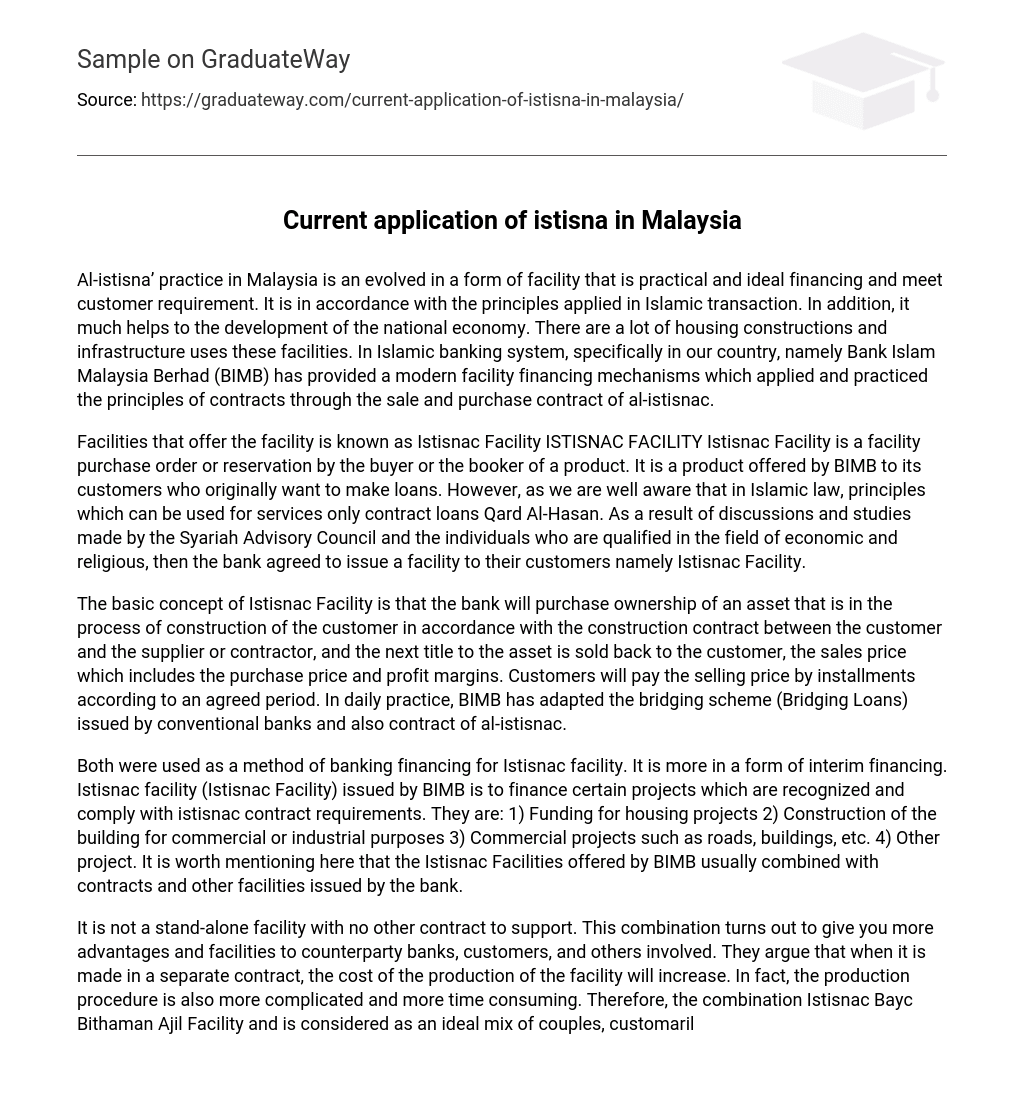Al-istisna’ practice in Malaysia is a practical and ideal form of financing that meets customer requirements, adhering to Islamic transaction principles. This practice significantly contributes to the development of the national economy. Many housing constructions and infrastructure projects rely on these facilities. In our country, specifically at Bank Islam Malaysia Berhad (BIMB), a modern facility financing mechanism has been implemented, applying the principles of contracts through the al-istisna’ sale and purchase contract.
Facilities provided by Istisnac Facility are commonly known as Istisnac Facility. It is a service where customers can place orders or make reservations for products. BIMB, a banking institution, offers this service to customers who initially seek loans. However, considering the principles of Islamic law, it is understood that services can only be provided through loans known as Qard Al-Hasan. Hence, after discussions and studies conducted by the Syariah Advisory Council and qualified individuals in the fields of economics and religion, the bank agreed to introduce a facility specifically for their customers called Istisnac Facility.
The idea behind the Istisnac Facility is that the bank will acquire ownership of an asset that is currently being constructed by the customer, based on the construction contract between the customer and the supplier or contractor. Afterwards, the bank will resell the asset back to the customer for a sales price consisting of the purchase price and profit margins. The customer will make payments towards the selling price in installments over a set period. In its everyday operations, BIMB has implemented both conventional bank’s bridging loans and al-istisnac contracts.
Both methods of banking financing, Istisnac facility (Istisnac Facility), were utilized as a form of interim financing. BIMB issues the Istisnac facility to finance specific projects that meet the requirements of an istisnac contract. These projects include funding for housing, constructing buildings for commercial or industrial purposes, commercial projects like roads and buildings, and other miscellaneous projects. It is important to note that BIMB often combines the Istisnac facility with contracts and other facilities issued by the bank.
It is argued that the Istisnac Bayc Bithaman Ajil Facility, when not stand-alone and supported by other contracts, offers more advantages and facilities to counterparty banks, customers, and others involved. Separately contracting the facility would increase production costs and make the production procedure more complicated and time-consuming. Therefore, combining the Istisnac Bayc Bithaman Ajil Facility is considered an ideal practice by the bank.
Practically, the two contracts have a continuity that is more effective compared to other instruments. The basic concept of the combination is that the customers will order for an item, for example, as customers want to buy a house from the developer. He would then find the bank and the bank will issue istisnac facility (Istisnac Facility) in which the bank will buy the goods (home) is (from the developer) and then sell it back to the customer. This process is done by using the booking contract.
Meanwhile, the payment transaction will be conducted through delay payment (Bayc Bithaman Ajil), by installments or as per the agreed terms between the bank and the customer. However, transactions that utilize these facilities, which are generally accepted by the bank, involve multiple parties. Within this facility, the bank frequently employs bridging finance (bridging financing), similar to what conventional banks practice. There are two payment levels for the sale executed by the bank. The initial stage consists of a 12 or 24-month period during which the funding covers the total payment of profits earned by the banks as a result of selling to the customer.
The second stage of the project involves accepting the total cost of the purchase. The bank will withdraw money for purchases made by the project and payment will be based on the project’s completion stage, determined and approved by a panel of architects. The bank can choose to receive higher payment through installments or a redemption price. The redemption price is set when third parties are interested in purchasing the project.
This process occurs at the end of the financing process when there are individuals interested in purchasing a small house that is being built through common projects undertaken by developers utilizing bridging finance on a per unit basis. These individuals will then receive a loan from a different bank, acting as a third party. As security for the loan, the bank will redeem the project title from BIMB. The redemption price of the property will be evaluated by BIMB and can be paid in installments or redeemed through the projects, whichever yields higher profits or both.
The Istisnac loan facilities offered by BIMB, despite being a contract in the Islamic Muamalat system, have been modified from the conventional bridging loan facility. However, bankers believe that the bridging finance facility provided by BIMB for istisnac financing is similar and compatible with the Istisnac facility.
Using this method, the bank will acquire projects from customers through a booking system. The purchase is made with negotiated prices between the bank and the customer. Afterwards, the bank will sell back the assets or projects to the customer. The sale price includes the purchase price and a profit rate for the bank. Redemption payments will be made through installments over an agreed period, or in a lump sum if deemed suitable by the bank.





